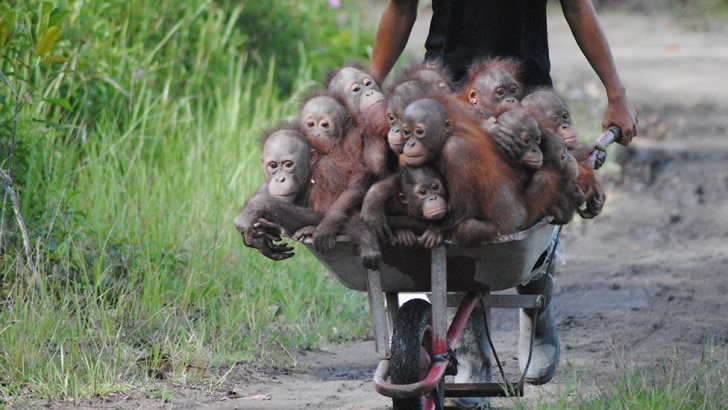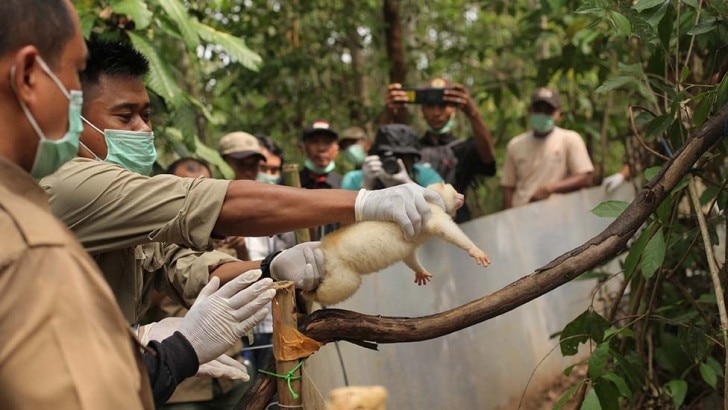BBC Earth newsletter
BBC Earth delivered direct to your inbox
Sign up to receive news, updates and exclusives from BBC Earth and related content from BBC Studios by email.
Animals
For some species, the road to release is a long one.
In many ways, humans have vastly improved how we treat captive wildlife. Once Romans routinely tortured and slaughtered lions, leopards, rhinos and even elephants in the Colosseum and bear-baiting was commonplace across Europe until the 19th century.
Today, with circus animals increasingly becoming a thing of the past (especially now the British government has banned them entirely), what happens too all those newly-freed animals that spent their lives in zoos and circuses or as pets? Can any animal, after years in captivity, ever be freed?

Even a lifetime in the most humane zoo will have left animals too affected by years of sheltered existence. Captive animals seldom learn crucial survival skills and often are too habituated to human contact. Lacking a natural fear of humans, they are vulnerable to poachers and ill equipped for life in the wild.
No case makes this more heartbreakingly obvious than the story of Keiko, the orca star of Free Willy (1993). A massive letter-writing campaign demanding his freedom led to Keiko being flown to Iceland in 1999 for release. Unfortunately, Keiko was ill-equipped for survival in the wild. Captured at a very young age and too accustomed to human contact, several attempts to help him join a wild pod failed. In the end, Keiko swam into a harbor in Norway, actively seeking the company of humans. He never managed to integrate with a wild population, struggled to hunt, and eventually died of pneumonia in 2002.
“Release to the wild is not automatically in the best interests of the animal,” says Dr Chris Draper head of animal welfare and captivity at Born Free – a charity that campaigns to keep animals in the wild. “The damage was done when that animal was brought in from the wild in the first place; it is dangerous to assume can could be released without just adding to the misery.”
Release to the wild is not automatically in the best interests of the animal”
For fish, reptiles, and amphibians, reintroduction can be fairly straightforward: frogs for example can often be bred in huge numbers in the lab and released to the wild. But with complex mammals such as primates, large cats, elephants, dolphins and whales, who may require years of instruction from their mothers, and an entire group of other members of their species in which they can thrive as adults, reintroduction is far more difficult.
“For the longest time, the idea of returning animals such as large mammals to the wild was just off the table, but now we’re seeing people in the field questioning the long-held belief that it’s impossible to return captive animals to their natural habitat,” says Katie Moore, deputy vice president of conservation and animal welfare for NGO the International Fund for Animal Welfare. “Yes, in a lot of cases it is still impossible, especially if the animals have been traumatised or were very young when captured. And you need to be very careful about introducing diseases to a wild population. But for some animals, if we proceed scientifically and thoughtfully, it can be done.”
Consider the African Lion and Environmental Research Trust (ALERT) in Zimbabwe, which for 15 years has worked to introduce lions to the wild. “Yes, lions can become habituated to humans, but we make sure the ones we released are not habituated,” says Dr Norman Monks, CEO of ALERT.
Their method of release involves multiple stages, which eventually sees the release of wild offspring from previously captive adults. First, lions that have been habituated to humans are released into a large enclosure with prey species to hunt. Next, those animals (which are never handled by humans again) eventually form a pride and produce new cubs. Then those cubs, who have grown together and formed social bonds, are eventually released as a pride.
“This is important, as we would not want to put these cubs into the wild if they were not a cohesive pride that would care for each other.” Because lions are highly social animals (and the only social species of cat), and their innate need to live within a pride needs to be taken into account when preparing them for release to the wild.
Many other groups are challenging old notions and working to develop new techniques tailored to the needs to different species to achieve what was once thought impossible, such as the Chimpanzee Rehabilitation Trust, Wildlife Vets International, and Born Free.
Wild release is easier for some animals than others, and the needs of individual species need to be carefully taken into account.
“One species that would be incredibly problematic is polar bears. They live in a highly specialised environment, and need to learn the skills to survive in that environment from their mothers. Learning those skills in a pre-release context would be next to impossible,” says Dr Draper. “But other kinds of bears seem to be reasonably successful when released back to the wild. But it depends so much on the individual animal: the age it was captured, whether it was bred in captivity, its experiences in captivity, any kinds of trauma, health, early nutrition. There is just no magic recipe.”

For many species, just as with lions, often the key is to release animals in groups. “Even chimpanzees that have lived in laboratories for many years can do pretty well when released in groups onto protected islands,” says Dr Draper.
Since 2006, conservationists at Orangutan Rescue in Indonesia have taken in orangutan infants who often have been kept as pets after their mothers were shot by famers for raiding crops. In the wild, an orangutan would spend up to nine years with its mother; an extraordinarily long time, even for a primate. This means orphaned orangutans require an exceptional amount of nurturing and education. Infants will spend anywhere from five to ten years at the centre being taught key survival skills such as how to climb trees, crack coconuts, fish for termites, and also that they need to fear threats such as spiders, snakes – and humans.
We try to be hands-off as much as possible. We try not to let them get attached to us, because we need them to learn not to trust people”
“We try to be hands-off as much as possible. We try not to let them get attached to us, because we need them to learn not to trust people,” says Karmele Llano Sanchez, program director of Orangutan Rescue at International Animal Rescue. “The key is that they learn more from each other than they do from us: one animal will learn a skill very quickly, and then go on to teach others. This is how they can re-learn how to be orangutans again. It takes many years and a lot of effort, but it has been surprisingly successful – I didn’t think the release program would go as well as it is. Even wild orangutans that have been brought to us after forest fires with injuries, or who have gone through starvation, can be brought back into good health and returned to the wild.”
Rehabilitating an orangutan doesn’t come cheap: with the costs of animal care at $250 a month, it may cost $5,000 or $10,000 to eventually release an animal, and their operations are always limited by funds.
There however is an upside to the high costs that come with caring for orangutans. “Yes the costs are high, but the money goes mostly to paying guides and trackers that follow them in the wild once we release them – we employ a lot of people,” says Sanchez. “This way we can get the buy-in of the community. It is ultimately an excellent way to provide an alternative income to hunting or logging.”
This points to one of the biggest challenges with reintroduction: finding suitable habitats in a world where hunting, logging, poaching and agriculture are erasing the wild places of the world.
“Demand for palm oil is growing, and so the problem of orphaned orangutans is only going to get worse because Malaysians are producing palm oil for the rest of the world,” says Sanchez.
“The dream is to never say never, but the reality of the world we live in means that even if the animal is physically capable of doing this, finding suitable release sites is extremely challenging,” says Dr Draper. “But we have to try. Yes, it is time consuming and it is expensive, but if it is possible, we have to try, simply because is the right thing to do.”
For some animals, reintroduction will always be difficult, such as baby elephants, or pet cheetahs, both of which habituate to human care very quickly, says Moore of IFAW. But we’ve only just started to challenge old ideas about reintroduction, and we have much to learn.
“If we don’t push boundaries we will never know what is possible,” she says.
Featured image by Getty